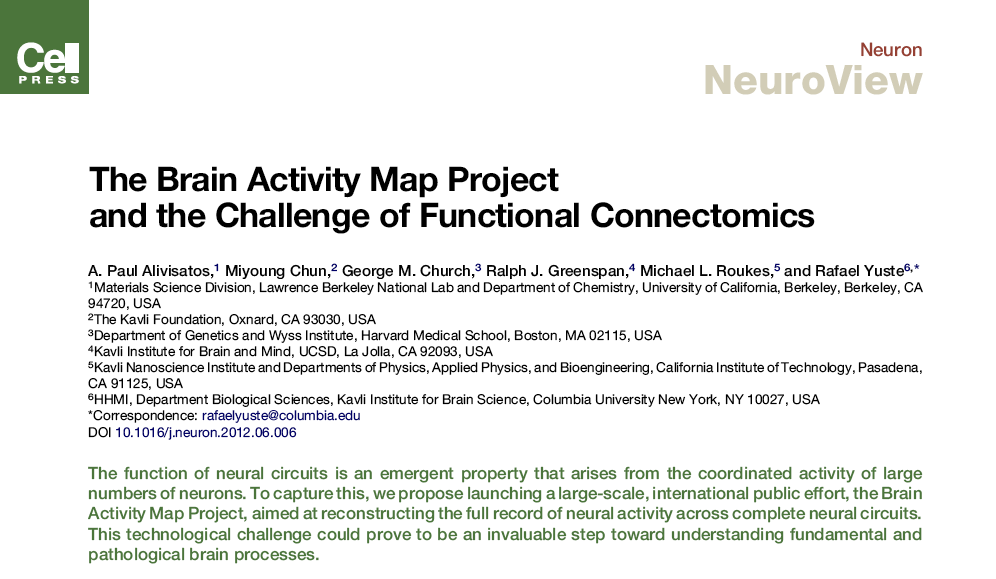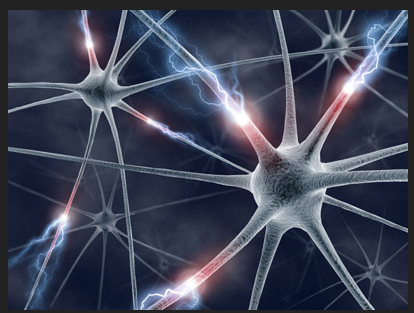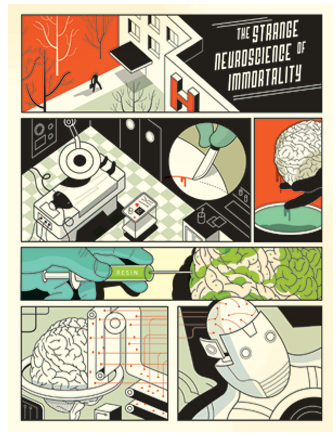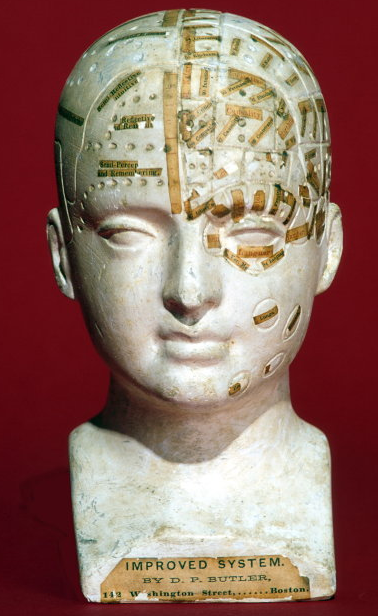Brain Mapping and the *-omics of Everything
"It is not down in any map; true places never are."
-Herman Melville
I recently gave a talk at the Tech Museum of Innovation in San Jose. Afterwards, John Markoff from The New York Times came up and introduced himself. I’m a fan of his work – I enjoyed his 2005 book What the Dormouse Said on the interplay between the counterculture and the computer industry and have also used it as source material for my own writing. ((Markoff’s book preceded Fred Turner’s more scholarly treatment From Counterculture to Cyberculture by a few years)) I asked John what he was working on and he just told me to keep an eye on tomorrow’s paper.Markoff's story - front-page, above the fold - revealed how the Obama administration is planning a major new initiative to map the active human brain. (Note: On February 25, a day after I first posted this, a follow-up article by Markoff appeared on-line.) As Markoff described it, the Brain Activity Map (BAM) project “would do for the brain what the Human Genome Project did for genetics.” The BAM project – which would be much more challenging than mapping the human genome – even got a shout out in Obama’s 2013 State of the Union address when the President noted that “our scientists are mapping the human brain to unlock the answers to Alzheimer’s” and hinted at the good things to follow if this work continued.BAM's basic goal is to create a dynamic map of the brain – it’s not clear whose grey matter will be studied but I can only imagine the field-day that Institutional Review Boards will have one day with this – rather than static maps. A June 2012 paper published in Neuron explains BAM’s goals. ((A earlier version of this paper from 2011 is available here. The report originated at a September 2011 conference at the Kavli Royal Society International Center and was organized by the Kavli Foundation, the Gatsby Charitable Foundation, and the Allen Institute for Brain Science.)) (The paper’s 6 co-authors are listed alphabetically. Together they are an odd ensemble of star scientists including Berkeley chemist Paul Alivisatos and Harvard geneticist George Church who I wrote about in an earlier post). According to their paper, the BAM project will “transcend the ‘structural connectome’” studied (and popularized) by people such as MIT’s Sebastian Seung. What intrigued me even more than BAM’s ambitious goals was the proposed methods. These would draw on some of the radical ideas for nanotechnology that have circulated since the mid-1980s in pop-science works like Eric Drexler’s Engines of Creation. For example, as Markoff described it, a “fleet of molecule-sized machines” – called “nanoprobes” in the Neuron paper – could noninvasively sense and record spikes of activity from every neuron. ((I discussed the "molecule-sized machines" idea at length with a colleague of mine at Caltech. He noted that these are passive sensors, not active nanobots - i.e. millions of silicon-based nanoprobes spaced out at the micron scale. Caltech's Michael Roukes, who is one of the BAM report authors, is a specialist in this line of research.)) This massive amount of data would be wirelessly transmitted and recorded, an activity that would require formidable information process capabilities. One approach to this might be “novel techniques” enabled by advances in synthetic biology. For example, DNA polymerases could be used as “spike sensors” while “prechosen DNA molecules could be synthesized” to record data patterns.BAM’s advocates make an economic as well as scientific argument for why the government should fund this decade-long endeavor at about $300 million/year. As Markoff points out, a recent Batelle study states that the $3.8 billion the feds spent on the Human Genome Project “drove $796 billion in economic impact” and “created 310,000 jobs.” Obama referenced these figures in his SOTU address. The Neuron paper predicted the BAM project might lead to similar “technological breakthroughs” at the interface of biotechnology and nanotechnology. These could include “intelligent nanosystems for fundamental investigations in the life sciences, medicine, engineering, and environmental applications; capabilities for storage and manipulation of massive data sets; and development of biologically inspired, computational devices.” In short – few tech sectors would be untouched by a major brain mapping project.Several aspects of the BAM project intrigue me. As a historian, I’m fascinated by the invocation of the Human Genome Project (HGP) as an analogy for why BAM should be done. George Church explained that the “genome project arguably began in 1984, where there were a dozen of us who were kind of independently moving in that direction but didn’t really realize there were other people who were as weird as we were.” Church clearly hopes to replicate (in a good way) some of that weird chemistry with BAM. I’d be really interested to hear from my history of biology colleagues as to ways in which the HGP has been harnessed to make the case for other big science projects. Also - can/should we think of ourselves as being products of our genome or our connectome? ((It seems as if everything has its own –omics these days: proteomics, epigenomics, and now connectomics. This meme has spread far beyond the life sciences – in the humanities we have “culturomics” while, in 2011, the Obama administration announced a “materials genome initiative” to “double the speed with which we discover, develop, and manufacture new materials.” I'm surprised there's no nano-omics yet but I guess that lexigraphical ship already sailed))
What intrigued me even more than BAM’s ambitious goals was the proposed methods. These would draw on some of the radical ideas for nanotechnology that have circulated since the mid-1980s in pop-science works like Eric Drexler’s Engines of Creation. For example, as Markoff described it, a “fleet of molecule-sized machines” – called “nanoprobes” in the Neuron paper – could noninvasively sense and record spikes of activity from every neuron. ((I discussed the "molecule-sized machines" idea at length with a colleague of mine at Caltech. He noted that these are passive sensors, not active nanobots - i.e. millions of silicon-based nanoprobes spaced out at the micron scale. Caltech's Michael Roukes, who is one of the BAM report authors, is a specialist in this line of research.)) This massive amount of data would be wirelessly transmitted and recorded, an activity that would require formidable information process capabilities. One approach to this might be “novel techniques” enabled by advances in synthetic biology. For example, DNA polymerases could be used as “spike sensors” while “prechosen DNA molecules could be synthesized” to record data patterns.BAM’s advocates make an economic as well as scientific argument for why the government should fund this decade-long endeavor at about $300 million/year. As Markoff points out, a recent Batelle study states that the $3.8 billion the feds spent on the Human Genome Project “drove $796 billion in economic impact” and “created 310,000 jobs.” Obama referenced these figures in his SOTU address. The Neuron paper predicted the BAM project might lead to similar “technological breakthroughs” at the interface of biotechnology and nanotechnology. These could include “intelligent nanosystems for fundamental investigations in the life sciences, medicine, engineering, and environmental applications; capabilities for storage and manipulation of massive data sets; and development of biologically inspired, computational devices.” In short – few tech sectors would be untouched by a major brain mapping project.Several aspects of the BAM project intrigue me. As a historian, I’m fascinated by the invocation of the Human Genome Project (HGP) as an analogy for why BAM should be done. George Church explained that the “genome project arguably began in 1984, where there were a dozen of us who were kind of independently moving in that direction but didn’t really realize there were other people who were as weird as we were.” Church clearly hopes to replicate (in a good way) some of that weird chemistry with BAM. I’d be really interested to hear from my history of biology colleagues as to ways in which the HGP has been harnessed to make the case for other big science projects. Also - can/should we think of ourselves as being products of our genome or our connectome? ((It seems as if everything has its own –omics these days: proteomics, epigenomics, and now connectomics. This meme has spread far beyond the life sciences – in the humanities we have “culturomics” while, in 2011, the Obama administration announced a “materials genome initiative” to “double the speed with which we discover, develop, and manufacture new materials.” I'm surprised there's no nano-omics yet but I guess that lexigraphical ship already sailed)) As I’ve explored in previous posts here and here, historical analogies have great power and their use should also come with some scrutiny. For example, neither Markoff’s article nor the Neuron piece commented on the fact that the HGP was spurred on by competition with Craig Venter and Celera Corporation. Might BAM eventually become a public-private hybrid or a competition between federally-funded researchers and those operating with private monies? ((The 2011 Kavli workshop that led to the BAM report was funded by some private money, including the Allen Institute for Brain Science...so, there is private money that has skin in the game.)) Moreover, comparisons between BAM and HGP reminded me that when scientists were lobbying for a National Nanotechnology Initiative (NNI) there would be the occasional allusion to the glory-years of the Apollo program. ((As Nobel laureate Richard Smalley advised Congress in 1999, “Somebody has to go out and put a flag in the ground and say: Nanotechnology, this is where we are going to go and we are going to have a serious national initiative in this area.”)) Obama's 2013 SOTU also drew up the 60s era push to space: "Now is not the time to gut these job-creating investments in science and innovation," the President said, "Now is the time to reach a level of research and development not seen since the height of the Space Race." Likewise, advocates of the NNI made economic, environmental, and health arguments as to why nano should be the next tech frontier Uncle Sam funded. ((Debates among scientist as to which is more important - your connectome or your genome - should be interesting topics for historians to explore. Perhaps these mirror nature vs. nurture debates which are, of course, not an either/or proposition. Also of interest would be the development of technologies to actually do brain mapping exercises...how is the field of neuroscience driven by technological and instrumental developments? How have these shaped research topics, etc. etc. - all the sorts of questions that STS scholars are well-equipped to study!))I am also intrigued by how advocates of BAM echo ideas from the early years of nanotechnology’s popularization. Although scientists like Smalley successfully marginalized images of bio-inspired nanobots – my Visioneers book has a chapter devoted to this – these ideas clearly had a powerful hold on the imagination of the public and policy-makers. So it’s intriguing to see references to “nanoprobes” and “biologically inspired, computational devices.” The self-replicating nanobots which could build things “atom by atom” that Drexler popularized are ancestors of a sort.Finally, the field of brain mapping – like nanotech of the early 1990s – has a small population of its own strange and/or fringy characters. In July 2012, The Chronicle Review ran an article called the “The Strange Neuroscience of Immortality.”
As I’ve explored in previous posts here and here, historical analogies have great power and their use should also come with some scrutiny. For example, neither Markoff’s article nor the Neuron piece commented on the fact that the HGP was spurred on by competition with Craig Venter and Celera Corporation. Might BAM eventually become a public-private hybrid or a competition between federally-funded researchers and those operating with private monies? ((The 2011 Kavli workshop that led to the BAM report was funded by some private money, including the Allen Institute for Brain Science...so, there is private money that has skin in the game.)) Moreover, comparisons between BAM and HGP reminded me that when scientists were lobbying for a National Nanotechnology Initiative (NNI) there would be the occasional allusion to the glory-years of the Apollo program. ((As Nobel laureate Richard Smalley advised Congress in 1999, “Somebody has to go out and put a flag in the ground and say: Nanotechnology, this is where we are going to go and we are going to have a serious national initiative in this area.”)) Obama's 2013 SOTU also drew up the 60s era push to space: "Now is not the time to gut these job-creating investments in science and innovation," the President said, "Now is the time to reach a level of research and development not seen since the height of the Space Race." Likewise, advocates of the NNI made economic, environmental, and health arguments as to why nano should be the next tech frontier Uncle Sam funded. ((Debates among scientist as to which is more important - your connectome or your genome - should be interesting topics for historians to explore. Perhaps these mirror nature vs. nurture debates which are, of course, not an either/or proposition. Also of interest would be the development of technologies to actually do brain mapping exercises...how is the field of neuroscience driven by technological and instrumental developments? How have these shaped research topics, etc. etc. - all the sorts of questions that STS scholars are well-equipped to study!))I am also intrigued by how advocates of BAM echo ideas from the early years of nanotechnology’s popularization. Although scientists like Smalley successfully marginalized images of bio-inspired nanobots – my Visioneers book has a chapter devoted to this – these ideas clearly had a powerful hold on the imagination of the public and policy-makers. So it’s intriguing to see references to “nanoprobes” and “biologically inspired, computational devices.” The self-replicating nanobots which could build things “atom by atom” that Drexler popularized are ancestors of a sort.Finally, the field of brain mapping – like nanotech of the early 1990s – has a small population of its own strange and/or fringy characters. In July 2012, The Chronicle Review ran an article called the “The Strange Neuroscience of Immortality.”
It focused on the work of Kenneth Hayworth, a postdoctoral researcher in Jeff Lichtman’s lab at Harvard University. A “self-described futuristic thinker,” Hayworth has developed a series of new machines that can help map the brain’s neural circuitry (the “connectome”). Hayworth’s automated “ultramictrotome”, for example, uses a tiny diamond saw to cut ultra-thin slices of brain tissue. Imaging these slices with an electron microscope can produce high-res maps – analogous to a circuit diagram – of them. What makes Hayworth’s research controversial is his belief that mapping the brain in exquisite detail is one path to brain preservation and eventual immortality. The Chronicle described it: “Then one day, not too long from now, his consciousness will be revived on a computer. By 2110, Hayworth predicts, mind uploading—the transfer of a biological brain to a silicon-based operating system—will be as common as laser eye surgery is today.” In other words, connectomics is, at least for Hayworth, one path to fulfilling the posthumanist dream of transcending the limits of the human body. “We've had a lot of breakthroughs—genomics, space flight—but those are trivial in comparison to mind uploading,” Hayworth said, “This will be earth-shattering because it will open up possibilities we've never dreamed of.”
To help realize his dream, Hayworth started the Brain Preservation Foundation. Currently, the Foundation offers a cash prize “for the first individual or team to rigorously demonstrate a surgical technique capable of inexpensively and completely preserving an entire human brain for long-term (>100 years) storage with such fidelity that the structure of every neuronal process and every synaptic connection remains intact...” Evan Goldstein interviewed me for his Chronicle piece. My response was that people like Hayworth have "ideas that stand out there as something to be looked at, maybe shot down, proven or disproven, but they are part of the process of staking out where the frontier of science is."
Parallels between Hayworth's activities and the early years of nano are striking. The Foresight Institute, a nanotech advocacy group that Eric Drexler helped start, offers large prizes to people who made significant advances in molecular engineering. Moreover, Hayworth’s goal and his approach (a non-profit funded by donations) resonates with those of the early nanoists. Like Drexler, Hayworth has turned to deep-pocketed entrepreneurs – Peter Diamandis, Peter Thiel, et al. – for support. Finally, one of the first communities to embrace radical ideas for nanotechnology in the 1980s were those with a keen interest in life extension technologies such as cryonics and mind uploading. As MIT’s Sebastian Seung – an advisor for the Brain Preservation Foundation – put it, “Mind uploading is part of the zeitgeist…People have become believers in virtual worlds because of their experience with computers. That makes them more willing to consider far-out ideas.” Similar affinities brought people from the computer science and software communities to the radical flavors of nanotech c. 1990.So, bringing this all back to BAM – I am looking forward to seeing whether and how a major national initiative do dynamic brain mapping takes shape. But already I’m fascinated by the ways in which BAM’s advocates have connected it to previous major national science initiatives as well as the dark matter of unusual ideas and individuals that forms a diffuse halo around the project.
